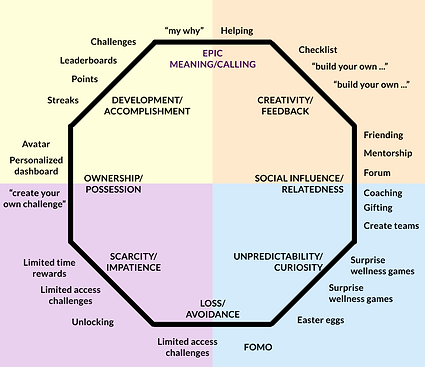CASE STUDY
Gamification for Well-being
I developed gamification guides that show how to use game mechanics in ways that truly support behavior change. The goal was to give product teams clear, practical tools for making health experiences more engaging and sustainable. These resources connect the science of motivation with hands-on strategies for platforms like WebMD ONE.
Gamification is the process of deriving the fun and engaging elements found in games and applying them to real-world activities.
This process is also sometimes called “Human-Focused Design,” as opposed to “Function-Focused Design.” It’s a design process that focuses on what humans find engaging or motivating, as opposed to what’s most efficient.
The Problem:
-
WebMD ONE wanted to improve engagement but lacked a clear gamification strategy.
-
Early attempts at gamification leaned on surface-level mechanics (e.g., step challenges) without tying them to user motivation or behavior science.
-
Users enjoyed the platform’s basic gamified tools, but beyond those, our teams didn’t really understand how gamification worked or how to apply it effectively. As a result, most features weren’t effectively gamified, and when attempts were made, they often missed the mark. Engagement was low, showing that without a clear framework, our approach failed to create lasting motivation.
Ineffective, imbalanced gamification - ~30% of users engaged

Effective, balanced gamification - Up to 90% of users engaged


The Approach:
1 - Research
Researched and applied the Octalysis Framework (Yu-kai Chou’s 8 Core Drives of Motivation).

3 - Foundation
The key to gamification success is 2 parts:
-
Gamify the things you really want the user to do
-
Apply diversified game techniques from all 8 core drives to maximize your engagement reach.
Defining the roll and priority that each product plays in the user journey helped us understand what to gamify more and what to gamify less.
4 - Guides
Completed team explorations and workshops and then created a structured set of gamification guides.
The Solution:
In order to get to true robust engagement, we recommended 3 things:
Gamification is powerful when it’s more than a gimmick. By grounding it in behavior science, I helped our teams design experiences that truly motivate users to keep improving their health.
Key Takeaways
Clear Frameworks
By distilling behavior change theory and Octalysis into accessible guides, I gave teams practical tools instead of abstract ideas. This clarity helped them approach gamification with confidence.
Smarter Engagement
Teams learned that gamification is more than points and badges. With the right frameworks, they could design features that truly motivated users and encouraged long-term habit formation.
Cultural
Shift
The guides didn’t just improve features — they changed how teams thought about engagement. Gamification became a shared language across design and product, aligning us around creating lasting impact.
